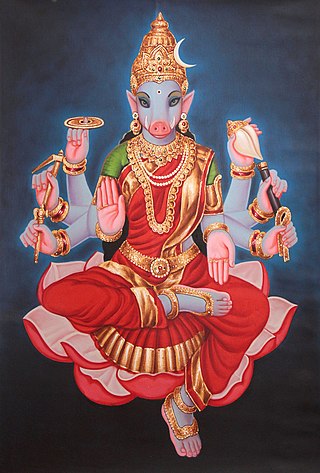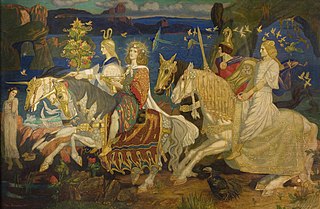Related Research Articles

A goddess is a female deity. In many known cultures, goddesses are often linked with literal or metaphorical pregnancy or imagined feminine roles associated with how women and girls are perceived or expected to behave. This includes themes of spinning, weaving, beauty, love, sexuality, motherhood, domesticity, creativity, and fertility. Many major goddesses are also associated with magic, war, strategy, hunting, farming, wisdom, fate, earth, sky, power, laws, justice, and more. Some themes, such as discord or disease, which are considered negative within their cultural contexts also are found associated with some goddesses. There are as many differently described and understood goddesses as there are male, shapeshifting, or neuter gods.

The Morrígan or Mórrígan, also known as Morrígu, is a figure from Irish mythology. The name is Mór-Ríoghain in Modern Irish, and it has been translated as "great queen" or "phantom queen".

The TuathaDé Danann, also known by the earlier name Tuath Dé, are a supernatural race in Irish mythology. Many of them are thought to represent deities of pre-Christian Gaelic Ireland.

Boann or Boand is the Irish goddess of the River Boyne (Bóinn), an important river in Ireland's historical province of Meath. According to the Lebor Gabála Érenn and Táin Bó Fraích she was the sister of Befind and daughter of Delbáeth, son of Elada, of the Tuatha Dé Danann. Her husband is variously Nechtan or Elcmar. With her lover the Dagda, she is the mother of Aengus.
In Irish mythology, *Danu is an obscure figure of Irish mythology, whose sole attestation is in the genitive in the name of the Tuatha dé Danann. Though primarily seen as an ancestral figure, some Victorian sources also associate her with the land.

In Irish mythology, the Badb, or in Modern Irish Badhbh —also meaning "crow"—is a war goddess who takes the form of a crow, and is thus sometimes known as Badb Catha. She is known to cause fear and confusion among soldiers to move the tide of battle to her favoured side. Badb may also appear prior to a battle to foreshadow the extent of the carnage to come, or to predict the death of a notable person. She would sometimes do this through wailing cries, leading to comparisons with the bean-sídhe (banshee).

Macha was a sovereignty goddess of ancient Ireland associated with the province of Ulster, particularly the sites of Navan Fort and Armagh, which are named after her. Several figures called Macha appear in Irish mythology and folklore, all believed to derive from the same goddess. She is said to be one of three sisters known as 'the three Morrígna'. Like other sovereignty goddesses, Macha is associated with the land, fertility, kingship, war and horses.

In Irish mythology, Ériu, daughter of Delbáeth and Ernmas of the Tuatha Dé Danann, was the eponymous matron goddess of Ireland.
In Irish mythology, Fódla or Fótla, daughter of Delbáeth and Ernmas of the Tuatha Dé Danann, was one of the tutelary goddesses of Ireland. Her husband was Mac Cecht.

Brigid or Brigit, also Bríg, is a goddess of pre-Christian Ireland. She appears in Irish mythology as a member of the Tuatha Dé Danann, the daughter of the Dagda and wife of Bres, with whom she had a son named Ruadán.
Cessair or Cesair is a character from a medieval Irish origin myth, best known from the 11th-century chronicle text Lebor Gabála Érenn. According to the Lebor Gabála, she was the leader of the first inhabitants of Ireland, arriving before the Biblical flood. The tale may have been an attempt to Christianize an earlier pagan myth.

Medb, later spelled Meadhbh, Méabh(a) and Méibh, and often anglicised as Maeve, is queen of Connacht in the Ulster Cycle of Irish mythology. Her husband in the core stories of the cycle is Ailill mac Máta, although she had several husbands before him who were also kings of Connacht. She rules from Cruachan. She is the enemy of Conchobar mac Nessa, king of Ulster, and is best known for starting the Táin Bó Cúailnge to steal Ulster's prize stud bull Donn Cúailnge.
Delbáeth or Delbáed was one of several figures from Irish mythology who are often confused due to the repetition of the name in the mythological genealogies.
Ernmas is an Irish mother goddess, mentioned in Lebor Gabála Érenn and "Cath Maige Tuired" as one of the Tuatha Dé Danann. Her daughters include the trinity of eponymous Irish goddesses Ériu, Banba and Fódla, the trinity of war goddesses the Badb, Macha and Mórrígan, and also a trinity of sons, Glonn, Gnim, and Coscar. Her other sons are Fiacha and Ollom. Ernmas was killed during the first battle of Mag Tuired and is called a "she-farmer" in the Lebor Gabála Érenn.
Flidas or Flidais is a female figure in Irish Mythology, known by the epithet Foltchaín. She is believed to have been a goddess of cattle and fertility.
A triple deity is a deity with three apparent forms that function as a singular whole. Such deities may sometimes be referred to as threefold, tripled, triplicate, tripartite, triune, triadic, or as a trinity. The number three has a long history of mythical associations and triple deities are common throughout world mythology. Carl Jung considered the arrangement of deities into triplets an archetype in the history of religion.
Mór Muman or Mór Mumain is a figure from early Irish literature who is said to have been a queen of Munster and daughter of king Áed Bennán. Her name means "the Great Mother" and the province of Munster is named after her. She is believed to be an euhemerised mother goddess and sovereignty goddess of the province, particularly of the Eóganachta. Mór Muman "personifies the land of Munster" and "the sovereignty of the region". She is also known as Mugain and may be the same figure as Anu and the Morrígan.
According to classical sources, the ancient Celts were animists. They honoured the forces of nature, saw the world as inhabited by many spirits, and saw the Divine manifesting in aspects of the natural world.

The gods and goddesses of the pre-Christian Celtic peoples are known from a variety of sources, including ancient places of worship, statues, engravings, cult objects, and place or personal names. The ancient Celts appear to have had a pantheon of deities comparable to others in Indo-European religion, each linked to aspects of life and the natural world. Epona was an exception and retained without association with any Roman deity. By a process of syncretism, after the Roman conquest of Celtic areas, most of these became associated with their Roman equivalents, and their worship continued until Christianization. Pre-Roman Celtic art produced few images of deities, and these are hard to identify, lacking inscriptions, but in the post-conquest period many more images were made, some with inscriptions naming the deity. Most of the specific information we have therefore comes from Latin writers and the archaeology of the post-conquest period. More tentatively, links can be made between ancient Celtic deities and figures in early medieval Irish and Welsh literature, although all these works were produced well after Christianization.
References
- ↑ T. W. Rolleston (24 July 2012). Celtic Myths and Legends. New York: Dover Publications. p. 132. ISBN 9780486265070.
- ↑ The Progress of the Sons of Mil from Spain to Ireland TCD H.4.22 Archived 2007-10-23 at the Wayback Machine , Celtic Literature Collective